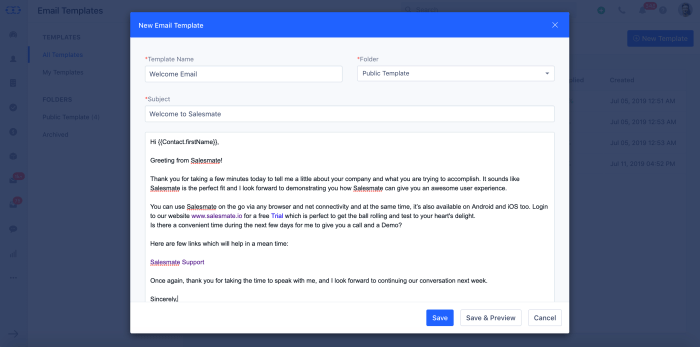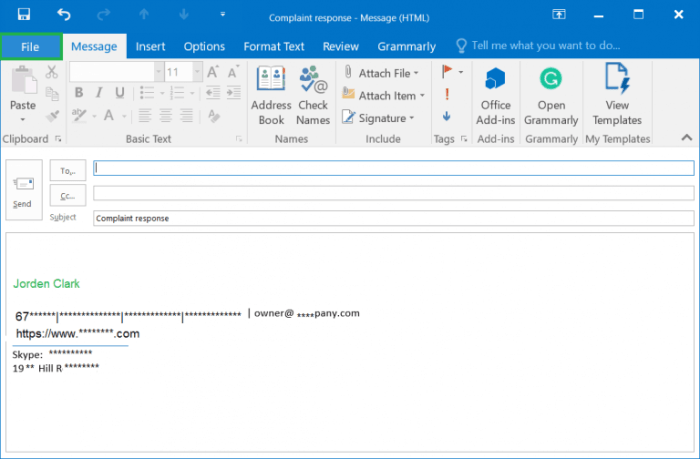Creating Email Templates opens up a world of possibilities for efficient and consistent communication. Dive into the realm of email template design and discover its impact on various industries and scenarios.
Introduction to Creating Email Templates
Email templates are pre-designed emails that can be used repeatedly to save time and ensure consistency in communication. They are essential tools for businesses and individuals looking to streamline their email correspondence.
Using email templates offers several benefits, such as increased efficiency by reducing the time spent on drafting repetitive emails. Additionally, they help maintain consistency in branding, messaging, and formatting across all communications. This consistency can enhance the professional image of the sender and improve customer experience.
Examples of Industries Using Email Templates, Creating Email Templates
- In the marketing industry, email templates are commonly used for newsletters, promotional offers, and follow-up emails to clients.
- Customer service departments often rely on email templates for responding to common inquiries, providing order confirmations, and seeking feedback from customers.
- Recruitment agencies use email templates for sending interview invitations, rejection letters, and onboarding information to new hires.
Components of an Effective Email Template
When it comes to crafting an effective email template, there are several key elements that should not be overlooked. From the subject line to the call to action, each component plays a crucial role in engaging the recipient and driving the desired response.
Subject Line
The subject line is the first thing the recipient sees and can make or break whether they open the email. It should be concise, compelling, and relevant to the content of the email to entice the recipient to click.
Greeting
A personalized greeting can make the recipient feel valued and more likely to engage with the email. Addressing them by their name or using other personal details can help establish a connection from the start.
Body
The body of the email should be clear, concise, and focused on the main message you want to convey. Use short paragraphs, bullet points, and visuals to make the content easily digestible.
Call to Action
Including a clear call to action prompts the recipient to take the desired next step, whether it’s clicking a link, making a purchase, or signing up for an event. Make sure the call to action stands out and is easy to find.
Signature
A signature provides a personal touch to the email and can include your name, title, contact information, and any relevant links or social media profiles. It adds credibility and makes it easy for the recipient to follow up with you.
Importance of Personalization in Email Templates

Personalization is key to creating a connection with your audience. By addressing recipients by their name, tailoring content to their interests, and using data to segment your audience, you can increase engagement and build trust with your email recipients.
Tips for Designing Visually Appealing Email Templates
When designing email templates, it’s essential to consider the visual appeal to capture the recipient’s attention and encourage them to engage with the content. Here are some tips for creating visually appealing email templates:
- Use a clean and simple layout to make the content easy to read and navigate.
- Incorporate images, videos, and graphics to break up text and make the email more engaging.
- Choose a color scheme that aligns with your brand and enhances the overall look of the email.
- Optimize the email for mobile devices to ensure it looks good on all screen sizes.
- Include white space to prevent the email from looking cluttered and overwhelming.
Tools and Software for Creating Email Templates

When it comes to creating email templates, having the right tools and software can make a huge difference in the efficiency and effectiveness of your email marketing campaigns. Let’s explore some popular options and compare their features.
Email Marketing Platforms with Template Creation Features
Many email marketing platforms offer built-in template creation features that allow you to easily design and customize email templates for your campaigns. Some popular platforms with these capabilities include:
- Mailchimp: Known for its user-friendly interface and drag-and-drop editor, Mailchimp offers a variety of pre-designed templates that you can customize to suit your brand.
- Constant Contact: Another popular choice, Constant Contact provides a range of customizable email templates and a user-friendly editor for easy customization.
- HubSpot: HubSpot’s email marketing tool includes a template editor that allows you to create responsive email templates and personalize them with dynamic content.
Comparing Built-in Template Editors vs. Third-Party Design Software
When it comes to designing and customizing email templates, you may also consider using third-party design software in addition to or instead of built-in template editors provided by email marketing platforms. Let’s weigh the pros and cons of each option:
- Built-in Template Editors:
- Pros:
- Convenient and integrated with your email marketing platform.
- No additional cost for using the editor.
- Templates are often optimized for specific email clients and devices.
- Cons:
- Limited customization options compared to third-party design software.
- May not offer advanced design features or flexibility.
- Pros:
- Third-Party Design Software:
- Pros:
- Greater flexibility and customization options for designing unique templates.
- Access to advanced design features and tools not available in built-in editors.
- Cons:
- May require additional cost for purchasing the software or subscription.
- Integration with your email marketing platform may not be as seamless as using a built-in editor.
- Pros:
Best Practices for Creating Email Templates
When it comes to creating email templates, following best practices is essential to ensure that your emails are effective in reaching your audience. Here are some key practices to keep in mind:
Importance of Responsive Design
Responsive design is crucial for email templates because it ensures that your emails are easily accessible and readable on all devices, including desktops, tablets, and smartphones. By designing your email templates with responsiveness in mind, you can provide a seamless user experience for your subscribers, no matter what device they are using.
Optimizing for Mobile Devices
Optimizing your email templates for mobile devices is vital, as a large percentage of email opens occur on mobile devices. To optimize for mobile, keep your email template simple and easy to navigate, use a single-column layout, ensure that your fonts are legible on smaller screens, and include clear call-to-action buttons that are easy to tap on a touchscreen.
Writing Compelling Copy and Using Visuals Effectively
When writing copy for your email templates, make sure to keep it concise, engaging, and relevant to your audience. Use personalization to make your emails more engaging, and include a clear and compelling call-to-action to encourage clicks. Additionally, using visuals such as images and videos can help grab your subscribers’ attention and make your emails more visually appealing.